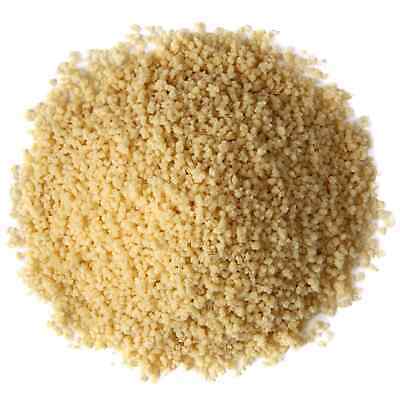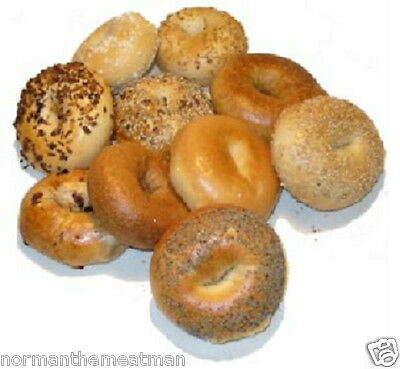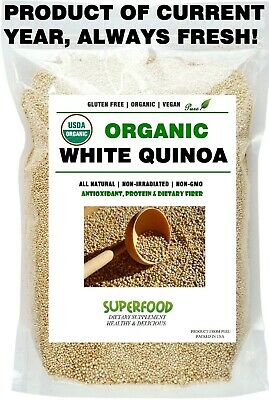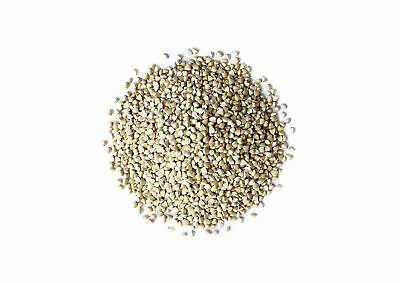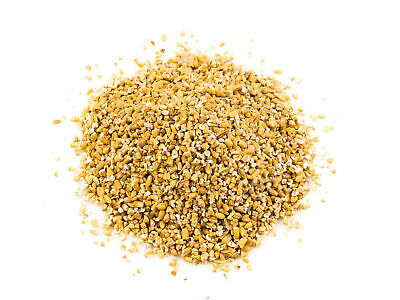-40%
Organic Whole Wheat Couscous by Food to Live (Non-GMO, Bulk, Kosher)
$ 6.59
- Description
- Size Guide
Description
Organic Whole Wheat Couscous by Food to Live (Non-GMO, Bulk, Kosher)Organic Whole Wheat Couscous
Certified Organic by A Bee Organic
Certified
Kosher
by
Union of Orthodox Jewish Congregations of America
Suitable for Vegetarians
Suitable for Vegans
Non-GMO
About the product:
PERFECT SWEET & SAVORY SIDE: Organic Couscous dishes can be sweet or savory as it goes well with anything.
ORGANIC CERTIFIED PRODUCT: Food To Live guarantees that our Organic Couscous is non-GMO and toxin-free.
ENERGIZING LOW-CALORIE MEAL: Eat couscous to get a burst of energy that comes at a cost of only a few calories.
NUTRITIOUS WHEAT PRODUCT: Organic Couscous contains wheat and gives you a boost of essential minerals, including iron.
PROTEIN-RICH FOOD: Organic Couscous from Food To Live contains a lot of protein, so it’s good for vegans and athletes.
Product description:
Couscous: Definition and History
Couscous is a type of ‘granular pasta’ traditionally made of semolina (coarse, purified wheat middlings). It can be called ‘granular’ because it’s extremely small. Organic Couscous from Food To Live is a top-quality product made with extreme care. We want to ensure that you enjoy this delicious dish and guarantee that our couscous will be tasty and fluffy if cooked right.
Wheat couscous originates from North Africa, where it’s considered a staple food. Note that some of the local countries treat is as a delicacy to be served on holidays and to commemorate special occasions. However, in many countries, it’s a food as common as pasta in the Western world.
Couscous traveled to Europe quite a few centuries ago and became extremely popular in Spain, Belgium, the UK, and other countries. Some surveys indicate that it’s the third most popular food in France, which is astounding as the French are very particular about the origins of their traditional dishes. This indicated that the people believe couscous to be an essential part of their culture.
Organic whole wheat couscous is usually cooked by steaming and served with a variety of foods. Its natural taste is so mild it’s barely noticeable. Therefore, it goes well with anything. You can serve it topped with stews, meat, vegetable, or fruits and nuts. You can also add it so salads or soups. To make a couscous dessert, just sweeten it with maple syrup or honey and enjoy with a glass of milk.
Food To Live Organic Couscous: Food for Every Occasion
Due to its extreme versatility, Organic Couscous from Food To Live can easily find a place at any table. Buying a bulk pack will allow you to enjoy this delicious and nutritious food for a long time.
Don’t be afraid of getting bored with it as you can change the taste of your couscous completely just by choosing a different seasoning.
As our product is organic certified, it doesn’t contain any harmful additives or GMO.
Is Couscous Pasta?
As it’s made of semolina or flour, couscous is, in fact, a type of pasta. However, it’s so tiny, most people believe it to be a grain. Nutrition-wise this product is close to one, but it has more carbs.
The traditional manual method of making couscous is extremely laborious. The semolina has to be rolled by hand into tiny pellets and sieved. It’s sprinkled with water to make it pliant and any granules that don’t match the requirements must be remade. The pellets are then left to dry under the sun.
In the olden times, the women gathered in groups and made couscous pellets together for several days. They produced huge batches of it that their families used for several months.
Today, machines do most of this work, which does not only save the time and health of women but also reduces the cost of production.
Is Couscous Vegan?
Couscous is the name of both the tiny granular pasta and the dish made from it. The former is 100% vegan by default, as long as you don’t’ cook it using meat broth.
On the other hand, whether the couscous recipe you make is vegan or not depends only on you as you’ll choose what to serve it with. Organic couscous goes well with everything, so you can enjoy it as both a vegan or a meat-eater.
Is Couscous Gluten-Free?
Traditional couscous is made of wheat and therefore it’s unsuitable for people with gluten sensitivity. However, today you can find some types of gluten-free couscous. This product must provide this information on the label alongside the list of ingredients.
Brown rice couscous is one of the most popular substitutes and it also is nutritious and tasty. Organic pearl couscous might also be gluten-free, depending on the flour it’s made of. However, bear in mind that the flavor and cooking techniques of these foods can differ from the original quite a bit.
Is Couscous a Carbohydrate?
As it’s a type of pasta, couscous is indeed a carb. However, it’s the good kind and doesn’t cause any sudden sugar level spikes. In fact, couscous carbs are a great ‘fuel’, so consider eating them for lunch.
A cup of the cooked product contains about 36 grams of carbohydrate. It’s 12% of the daily recommended amount, based on the standard 2,000-calorie diet. This means that couscous carbs are sufficient to give you a small boost of energy and help ward off hunger pangs for a while.
Interesting Couscous Nutrition Facts
Few people realize that despite not being a whole grain, couscous is rich in a variety of essential nutrients. It contains fairly large amounts of calcium and iron.
Couscous calories are so few that you can include it in any weight management plan.
Bodybuilders should enjoy couscous regularly as this product contains 6 grams of protein per cup. The amino acids you get from this food are easy for the body to digest and use.
As it always is with plant proteins, the ones you get from couscous are ‘incomplete’. However, eating them with vegetables and/or legumes provides a range of amino acids necessary to ‘complete’ them. Therefore, couscous is great for vegans as well.
Organic couscous contains trace amounts of selenium, which is hard to come by in plant foods. This element is an essential antioxidant that your body needs to function properly.
Organic Couscous Health Benefits
Due to the fact that it contains potassium and selenium, couscous makes a good heart-friendly food. However, don’t forget that it does contain quite a bit of carbs, so you should control the size of your portions.
Organic couscous contains dietary fiber, which benefits your digestive tract by ‘exercising’ it while it travels through your body. Eating high-fiber and protein foods is associated with improved wellbeing and stronger immunity.
Cooking Couscous: Traditional Couscous Steamer
Archeologists and food historians believe that original implements for cooking couscous were made from organic materials. Therefore, none of them remain for us to see in museums. Today, the people of North Africa use a special type of couscous cooker that allows making the stew and steaming couscous at the same time.
The Berber call it ‘taseksut’, but the French name ‘couscoussier’ is easier for the Westerners to understand. This type of couscous pot consists of three elements, a base pot (big and tall), a steamer, and a lid. The stew cooks in the base and couscous soaks up the ‘fumes’ coming from it and becomes much tastier.
There are some other types of cookers, but the underlying idea for them is the same. Note that the type of couscous you use will determine the couscous-water ratio. If you go with the instant product, you should stick to 1 ¼-½ cup per 1 cup of dry product.
However, if you are using a traditional steamer, the couscous-to-water ratio should be about 1-to-2. It depends on the stew in the base of the cooker. Note that you’ll need to take the grains out of the steamer and roll them around on a baking sheet 2-3 times during cooking. Drizzle a bit of olive oil to make the task easier. This will ensure your couscous in pleasantly fluffy. The traditional cooking will produce a much more flavorful dish than instant couscous.
Traditional Couscous Dishes Around the World
Despite this food being a staple for many neighboring nations, couscous meals vary greatly in some countries. Some of the traditional ways to serve this dish include:
·
Savory couscous: Algerian and Moroccan.
Both the Algerians and Moroccans usually consume couscous with a meat and vegetable stew served on top. Rarely, this delicacy is served as dessert. In this case, it’s sprinkled with almonds and honey.
·
Hot couscous: Tunisian.
While the people of Tunisia can serve couscous with anything, including squid and octopus, they almost always season it with a hot harissa sauce. Here this dish can be served every day as people enjoy it greatly.
·
Israeli couscous.
In Israel couscous is a delicacy served on special occasions. It’s mostly used as a savory dish with vegetables and meat. This country also has its own special variety of it, called Israeli or pearled couscous, which is a type of toasted pasta.
·
Mediterranean couscous variations.
The Mediterranean cuisine often allows for couscous to be a substitute for rice or other grains. The dishes are mostly savory and involve lots of vegetables and sometimes meat. These recipes usually involve rich, spicy seasonings.
Couscous ingredients vary greatly from culture to culture as it goes amazingly well with any topping. Sweet couscous recipes are very simple as the food is cooked in plain water. People usually flavor these dishes with honey and sprinkle them with nuts and dried fruits. Couscous desserts are served with milk.
Couscous Salad: Nutritious Vegan Lunch Recipe
Ingredients:
·
1 cup organic couscous cooked in vegetable broth
·
¾ cup cooked garbanzo beans
·
2 tablespoons scallions (chopped)
·
½ cup cucumbers (diced)
·
¼ cup bell peppers (diced)
·
½ teaspoon lemon zest
·
3 tablespoons balsamic vinegar
·
1 tablespoon Dijon mustard
·
1 tablespoon olive oil
Instructions:
1.
Lightly toss together couscous, cucumbers, bell peppers, scallions, and beans.
2.
Mix the rest of the ingredients thoroughly in a small bowl to make the seasoning.
3.
Combine all ingredients and season your couscous salad with salt and pepper to taste.
This couscous recipe would be a great choice for a lunch to enjoy at work. It’ll take less than 10 minutes to make when you have couscous and beans pre-cooked. You can add any other veggies to make the salad suit your taste.
Couscous Cooking and Storage Tips
Food To Live Organic Couscous keeps for months if stored in a dark dry place. Keep it in an airtight container to prevent damage from moisture and mold. There is no need to store this type of dry goods in the fridge, so just leave it in your pantry. In fact, you can keep the organic couscous bulk package in one of the kitchen cupboards.
As you can store organic couscous for years, you’ll have enough time to experiment with various recipes. However, there are some tricks that will help you make this dish more delicious regardless of the exact recipe.
·
Always cook your organic couscous in a broth instead of water.
You can forego this advice when making a sweet couscous dessert. However, in this case, you can flavor the water with anise, cinnamon, or some other spices. Couscous soaks up the flavors while cooking, so it’ll be more delicious when the liquid infusing it has some flavor of its own.
·
Fluff your couscous really well.
Giving it a few stirs with a fork will result in a clumpy mass instead of proper couscous. The best way to do it is to break down the cooked mass by hand fluffing it thoroughly. Put the couscous onto a baking sheet lined with a kitchen towel to do this well.
·
Serve when still warm.
At the very least, you should serve room-temperature couscous as it gets clumpy when cold. This will make the texture of the dish unpleasant and will prevent it from soaking up seasoning well.
·
Limit the use of liquid seasonings.
Don’t drench your organic couscous in the vinaigrette as this will ruin its fluffy texture and make the taste too strong. This food is a bit bland by default, which is why it makes such a great side. However, it soaks up flavors extremely well because of this, so there would be no saving your couscous dish if you add too much seasoning.
You can pre-cook your organic couscous for the ease of cooking on workdays. It can be stored for up to a week in the fridge if you put it in an airtight container.
Payment
Shipping
Returns
PayPal is the preferred payment method.
We ship every day Monday - Friday.
We hope you will love your purchase, however, if you need to return it, we have a 30-day return policy.
